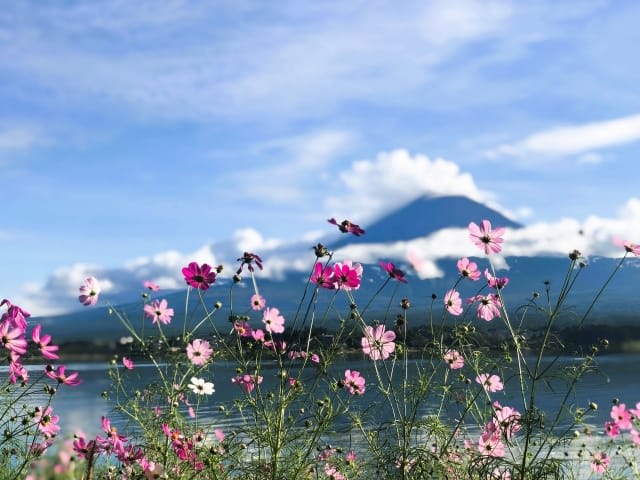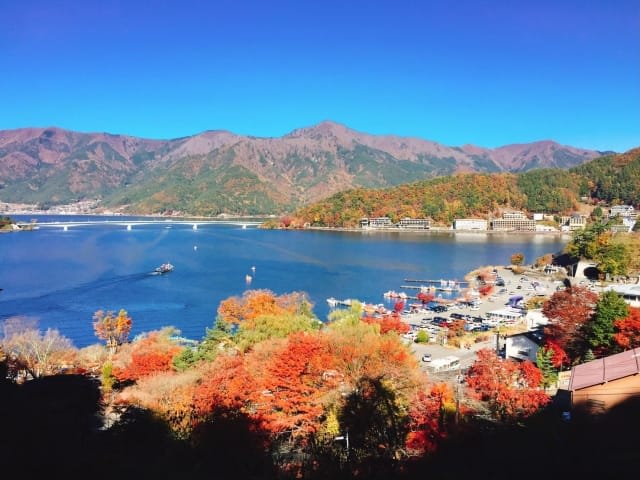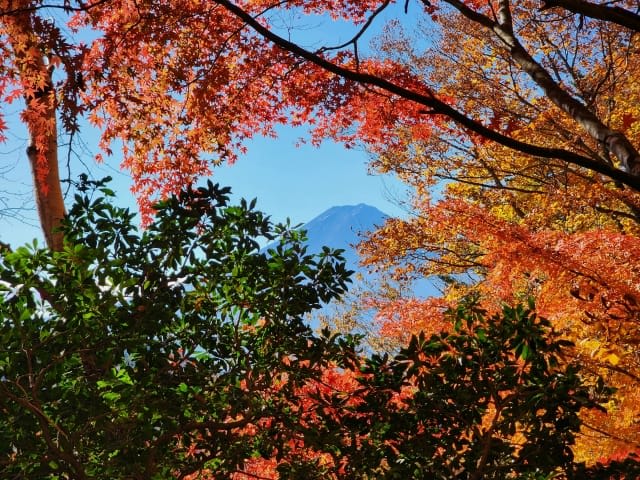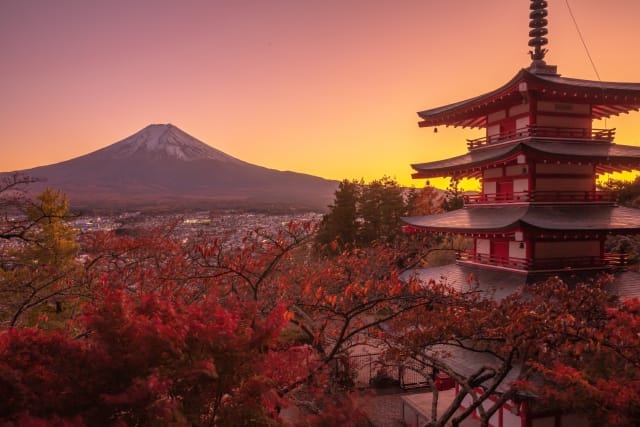Autumn at Mt. Fuji: A Complete Guide for Foreign Visitors
Due to Mount Fuji's massive size and the scattered tourist spots around its base, planning an efficient itinerary can be quite challenging for visitors. I remember when I first visited the Mount Fuji area, I wasn't able to efficiently visit the surrounding attractions, which left me feeling like I hadn't fully experienced what the region had to offer.
As a result, tours that offer an efficient and immersive way to experience the Mount Fuji area are gaining popularity. Private tours led by guides who know the Mount Fuji region inside and out are especially in demand, as they're known for allowing small groups to fully enjoy both the cultural and natural attractions around the mountain.
Magical Trip, which boasts having the #1 rated tour of 2024, launched a new tour in November 2024 called "Mt. Fuji Full-day Nature Guided Tour with a Private Chartered Car." On this tour, a driver and an expert local guide take you to carefully selected must-see spots around Mt. Fuji while explaining the local culture and traditions.

Since the tour starts and ends at your Tokyo hotel, you can explore the Mt. Fuji area hassle-free. If you're interested in Mt. Fuji but don't have time for an extended stay in the area, consider this efficient sightseeing tour.
Introduction
Standing at the foot of Mt. Fuji in autumn, I'm always struck breathless by the spectacular view. The contrast between the fall-colored trees and snow-capped Mt. Fuji is just like a painting. As someone who has been visiting this mountain for 10 years, this season holds a special charm for me.
The clear air and cool breeze calm the summer bustle. During this season, Mt. Fuji appears more divine, showing its form more distinctly. The mountain's base is full of life with people enjoying autumn leaf viewing, fall festivals, and tourists seeking seasonal delicacies.
However, these wonderful views come with challenges. Popular spots can get crowded, making it difficult to enjoy the scenery at leisure. The weather can be unpredictable, and there are days when clouds hide Mt. Fuji from view.
Still, the charm of Mt. Fuji in autumn is extraordinary. The landscape created by Mt. Fuji, Japan's symbol, and the autumn leaves symbolizing Japan's seasonal beauty will become a lifelong memorable experience.
So, why don't you experience the charm of Mt. Fuji in autumn?
Table of Contents
・Mt. Fuji in Autumn: Attractions and Highlights
・Fall Foliage Spots Around the Fuji Five Lakes
・Best Season for Autumn Mt. Fuji Tourism
・Important Notes for Autumn Mt. Fuji Tourism
・Access Methods from Tokyo to Mt. Fuji
・Frequently Asked Questions About Autumn Mt. Fuji
Mt. Fuji in Autumn: Attractions and Highlights

Autumn at Mt. Fuji is a season of nature's artistry. From my 10 years of regular visits, I'm convinced it's the most attractive season.
The contrast between vivid autumn leaves and the majestic Mt. Fuji creates an absolutely stunning view. With summer's humidity gone, comfortable sightseeing can be enjoyed under clear blue skies. While the climbing season has ended, the temperature is perfect for tourism, making it less tiring for extended walks.
During this season, various autumn festivals and events are held, offering abundant opportunities to experience local traditional culture. Particularly at dusk, you can see "Red Fuji" when the mountain slopes turn red, attracting many photography enthusiasts.
Furthermore, autumn offers many clear days when Mt. Fuji's form is distinctly visible, making it an excellent season for photography. At the mountain's base, you can enjoy activities like matsutake mushroom hunting and sweet potato harvesting, savoring Japan's autumn flavors.
Fall Foliage Spots Around the Fuji Five Lakes
The Fuji Five Lakes area is dotted with spectacular viewing spots for Mt. Fuji and autumn leaves. I'll introduce particularly attractive locations I've carefully selected from years of experience.
Lake Kawaguchi Area

Lake Kawaguchi is one of my most frequently visited autumn leaf spots. The autumn leaves festival held from late October to mid-November features 400-500 maple trees planted along the lake shore, creating a spectacular view. The nighttime illumination is magical, offering a different aspect from daytime views.
The Maple Corridor features about 70 maple trees forming a colorful tree-lined path perfect for strolling. Oishi Park offers a magnificent panorama of Mt. Fuji and autumn leaves, making it a classic photo spot. From the Kachikachi Ropeway at Tenjoyama Park, you can enjoy an aerial walk overlooking the autumn-colored lakeside and Mt. Fuji.
Lake Yamanaka Area

The Sunset Shore at Lake Yamanaka is a spectacular spot selected as one of Japan's 100 Best Beaches. The autumn leaves festival held from late October to early November has been a tradition since 2006, and I look forward to it every year.
Brochures are distributed at the venue's information center, making it easy for first-time visitors to enjoy sightseeing. The staff are friendly and provide detailed guidance about photo spots.
Benches are installed so you can enjoy a picnic while viewing Mt. Fuji. At night, the autumn leaves are illuminated, creating a magical atmosphere different from daytime.
Other Areas

The Fuji Five Lakes area has many more wonderful autumn leaf spots.
At Iyashi no Sato Nenba at Lake Sai, you can enjoy the traditional Japanese landscape created by thatched-roof old houses and autumn leaves. At Lake Motosu, which I often visit, the collaboration of the inverted Mt. Fuji reflection on the water surface and autumn leaves is spectacular, and I recommend photographing in the quiet early morning.
The five-story pagoda at Arakurayama Sengen Park is my absolute favorite spot. The composition including the pagoda, autumn leaves, and Mt. Fuji creates a spectacular view that condenses Japan's beauty. At the quieter Lake Shoji, you can enjoy autumn leaf viewing with relatively fewer tourists.
Fuji Q Highland is recommended for families. You can enjoy both amusement park fun and autumn leaf viewing simultaneously, making it enjoyable for both children and adults.
Best Season for Autumn Mt. Fuji Tourism

From my 10 years of observation experience, I can confidently say that the best time to see Mt. Fuji's autumn leaves is from mid-October to mid-November. However, this can vary slightly depending on that year's temperature and weather conditions.
During this period, daytime temperatures are comfortable at 59-68°F (15-20°C), dropping to 41-50°F (5-10°C) in the morning and evening. The climate is ideal for tourism, making extended walks comfortable. Rainfall is relatively low, with many clear days, increasing the chances of seeing Mt. Fuji.
While the intense summer tourist crowds have subsided, there's still a distinctive bustle during the autumn leaves season. The autumn festivals held in various locations offer illuminations and events, making nighttime tourism attractive as well.
Important Notes for Autumn Mt. Fuji Tourism

From years of experience, I'd like to share particularly important points for autumn Mt. Fuji tourism.
First, cold weather preparation is essential. The morning and evening chill is more severe than expected, especially for early morning photography or nighttime illumination viewing, requiring warm gear like fleece or down jackets.
The autumn leaves conditions change daily depending on weather. Every year, I check the latest information through local tourism associations and social media. This allows me to enjoy autumn leaf viewing at the best timing.
Regarding transportation, public transport tends to get crowded during the autumn leaves season. I recommend making early train and bus reservations, especially for weekends. Similarly, popular accommodation facilities get booked up early, so planning ahead for reservations is important.
Don't forget camera equipment preparation. You'll definitely want to record the spectacular views of Mt. Fuji and autumn leaves. When shooting with smartphones, carrying a mobile battery is essential as battery consumption is faster.
Access Methods from Tokyo to Mt. Fuji
Mt. Fuji has various well-organized transportation options. From my experience, I'll introduce the most convenient routes with scenic views.
Access by Train
From Tokyo Station, using the Fujikyu Line, you can reach Kawaguchiko Station in about 2 hours. The "Fuji Excursion" from Shinjuku to Kawaguchiko is particularly popular among tourists. With reserved seating and no transfers required, you can enjoy a comfortable journey.
Another route is taking the Shinkansen from Tokyo Station to Mishima Station, then taking a bus to Kawaguchiko. This takes about 2 hours and 30 minutes. With an IC card (Suica or PASMO), transfers are smooth.
Access by Bus
From Shinjuku Station, highway buses reach Kawaguchiko Station in about 2 hours. Many buses require reservations, so I recommend booking in advance. Early reservations are particularly wise during the autumn leaves season.
From the bus window, you can enjoy views of Mt. Fuji and autumn leaves. On clear days, you can see Mt. Fuji's majestic form on the right side of the travel direction, making the journey itself part of the sightseeing experience. The view of Mt. Fuji from the highway is one of my favorites.
Frequently Asked Questions About Autumn Mt. Fuji
Based on my 10 years of Mt. Fuji visits, I'll answer commonly asked questions.
What's the Best Spot to Photograph Mt. Fuji with Autumn Leaves?

I confidently recommend Arakurayama Sengen Park. The collaboration of the five-story pagoda, Mt. Fuji, and autumn leaves is world-famous as a Japanese spectacular view. Visiting early in the morning means fewer tourists and relaxed photography opportunities.
On Lake Kawaguchi's north shore, the contrast between Mt. Fuji reflected on the lake surface and autumn leaves is spectacular. From Oishi Park, you can enjoy a panoramic view of autumn leaves with Mt. Fuji in the background, allowing even beginners to take wonderful photos.
Nagaike Water Park is one of my secret photography spots, featuring inverted Mt. Fuji reflections and autumn leaves on the water surface. Lake Motosu is also known as a famous Mt. Fuji viewpoint, offering particularly attractive scenery during autumn leaves season.
What Activities Can Be Enjoyed Around Mt. Fuji in Autumn?
Beyond autumn leaf viewing, various activities can be enjoyed. Well-maintained hiking trails around the lakes and mountain base allow close-up enjoyment of autumn leaves. I recommend boat rides on Lake Kawaguchi or Lake Yamanaka. The view of autumn leaves and Mt. Fuji from the lake is exceptional.
Hot spring hopping is also a highlight of autumn Mt. Fuji tourism. You can relax both mind and body while viewing Mt. Fuji from open-air baths. Additionally, well-maintained cycling roads along the lakes and mountain base allow you to enjoy the surrounding scenery leisurely while feeling the refreshing autumn breeze.
What's Appropriate Clothing for Autumn Mt. Fuji Tourism?
From years of experience, I'll share clothing selection points. First important is layered clothing. Due to large temperature differences between morning and evening, I recommend combining thin shirts, sweaters, fleece, and down jackets.
Comfortable walking shoes are essential for hiking and extended walks. While autumn has many clear days, I recommend bringing hats and sunglasses for UV protection. For sudden weather changes, folding umbrellas and raincoats are must-haves.
Autumn at Mt. Fuji is the season when Japan's natural beauty can be most felt. It's packed with elements that enchant visitors, including the contrast between autumn leaves and Mt. Fuji, comfortable climate, abundant tourist spots and experiences, and seasonal flavors.
My advice from 10 years of visiting Mt. Fuji is to make plans with plenty of flexibility. While popular spots can get crowded, aiming for early morning or evening allows you to enjoy the spectacular views of Mt. Fuji and autumn leaves in a quieter environment.
Please use the information introduced in this article to fully enjoy your autumn Mt. Fuji tourism!



